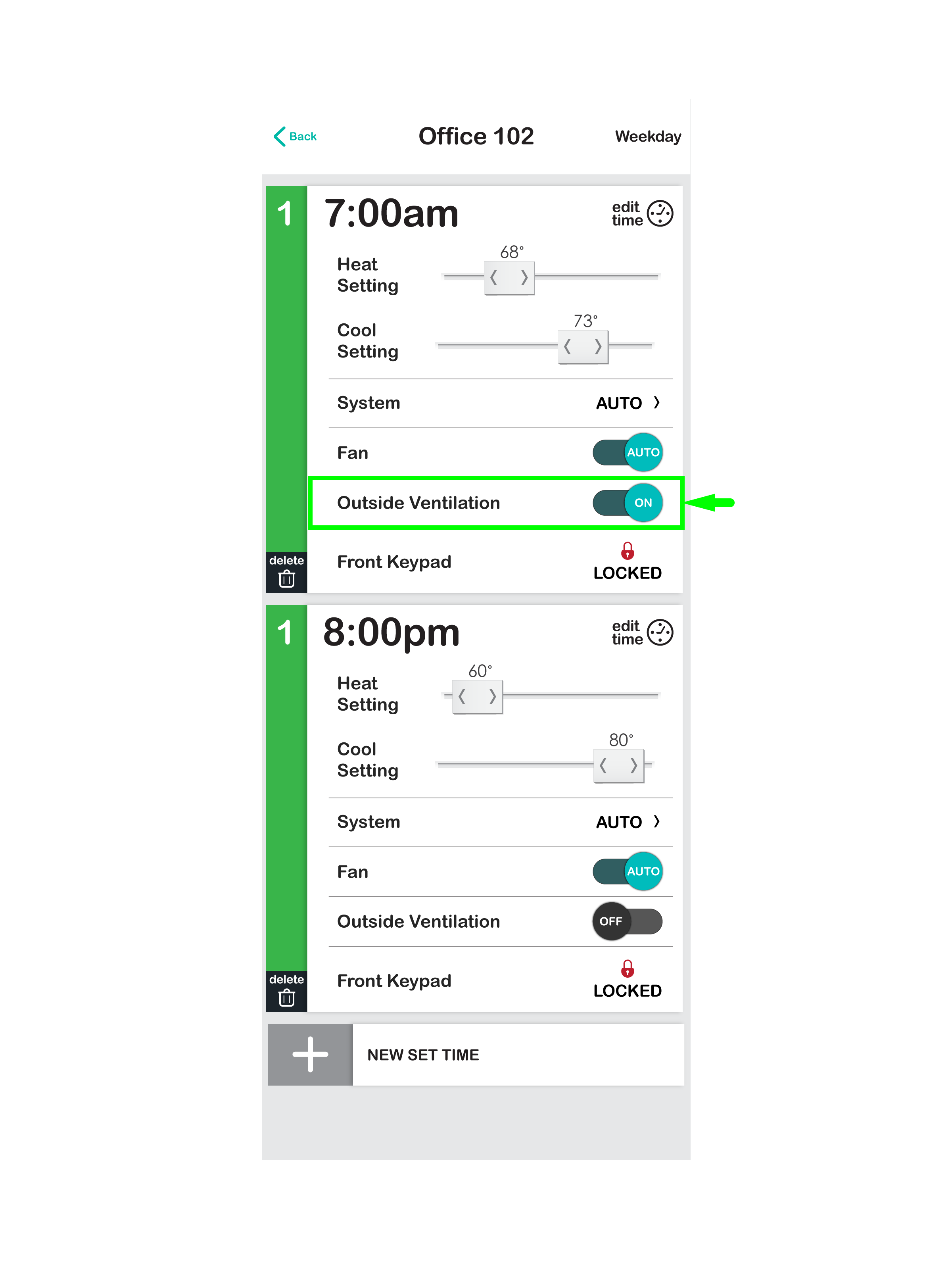How and when do I use this schedule feature?
In most buildings there are periods when you need to ventilate, such as: directly before the room is occupied, during occupied hours, and slightly after the room becomes unoccupied. Then there are periods when you do not need to ventilate, such as unoccupied hours. This section walks you through how to use this Pelican scheduling feature to manage when your building’s ventilation is active and when it is not.
How do I schedule when Outside Ventilation is enabled and not?
Each thermostat schedule provides multiple set-times and each set-time can either allow Outside Ventilation or disable it. To switch a set-time between these options, you will need to navigate to a thermostat’s schedule management page or the Shared Schedule dashboard where you can adjust a schedule’s set-times.
If a set-time’s Outside Ventilation is set to ON, then the thermostat will open the outside damper for ventilation anytime a Fan, Cooling, or Heating cycle occurs at and after that time. This will remain true until Outside Ventilation is either disabled manually, through the web-app, or automatically through another scheduled set-time.
As can be seen in the example below, Outside Ventilation is enabled at 7:00 am, and will remain enabled until the next scheduled set-time which disables it at 8:00 PM that day.

If a set-time’s Outside Ventilation is set to OFF, then the thermostat will not open the outside damper for ventilation anytime a Fan, Cooling, or Heating cycle occurs at or after that time. This will remain true until Outside Ventilation is either enabled manually, through the web-app, or automatically through another scheduled set-time.
As can be seen in the example below, Outside Ventilation is disabled at 8:00 PM, and will remain disabled until the next scheduled set-time which will be 7:00 AM the next day.

How does it work?
When Outside Ventilation is set to ON, anytime the room thermostat calls for Fan, Cool, or Heat the outside air damper will be placed at its configured minimum ventilation position. When Outside Ventilation is set to OFF, anytime the room thermostat calls for Fan, Cool, or Heat your outside air damper will remain closed.
This is also true for rooms that have Pelican Carbon Dioxide (CO2) sensors. When Outside Ventilation is set to ON, anytime the room thermostat calls for Fan, Cool, or Heat the outside air damper will be placed at its configured minimum ventilation position. And anytime CO2 levels are above the room’s CO2 threshold, a Demand Ventilation Cycle will begin and the outside air damper will be opened further, increasing ventilation rates into the room.
Why is it efficient?
During unoccupied hours it is inefficient to ventilate a room since people are not present and the outside air might not be at an ideal temperature to mix with the room during that period. (If it is, then that would be called an economizer cycle, which is explained further here).
For example, during unoccupied hours if the room thermostat is set to maintain a heat set-point of 65°F and the room drops below 65°F, the thermostat will enable heating. But, because the room has no people in it, there is no reason to ventilate the space since this can cost the building owner more energy than just heating the room’s return air temperature (especially if the outside air is below 50°F).
How does this provide greater comfort?
It is important to remember that HVAC stands for Heating, Ventilation, and Air Conditioning, with ventilation being a very important aspect of comfort and safety for the occupants in your building. By being able to schedule ventilation periods and confirm they are operating correctly through your Pelican solution, means your facility is a million steps ahead of others who have no idea when or if their ventilation is active. The Pelican solutions is first and foremost focused on the comfort and safety of your occupants, energy efficiency should only be utilize during periods where a reduction in ventilation has no negative impact on these primary comfort and safety metrics.
If you want to learn more about the risk of poor ventilation in commercial buildings, search Sick Building Syndrome and the Internet provides, in detail, the different health issues that have come from poor indoor ventilation.
How do I ventilate to COVID-19 government recommendations?
Recommendations by organizations such as ASHREA (American Society of Heating, Refrigerating and Air-Conditioning Engineers) and the CDC (Centers for Disease Control and Prevention) are to ventilate your commercial spaces two hours pre-occupancy, continuously during occupied hours, and then two hours post-occupancy. Below is a demonstration of how a schedule might look when setting this sequence up for your Pelican thermostats.
The example below assumes that the business’s normally occupied hours start at 7:00 AM and end at 7:00 PM.

